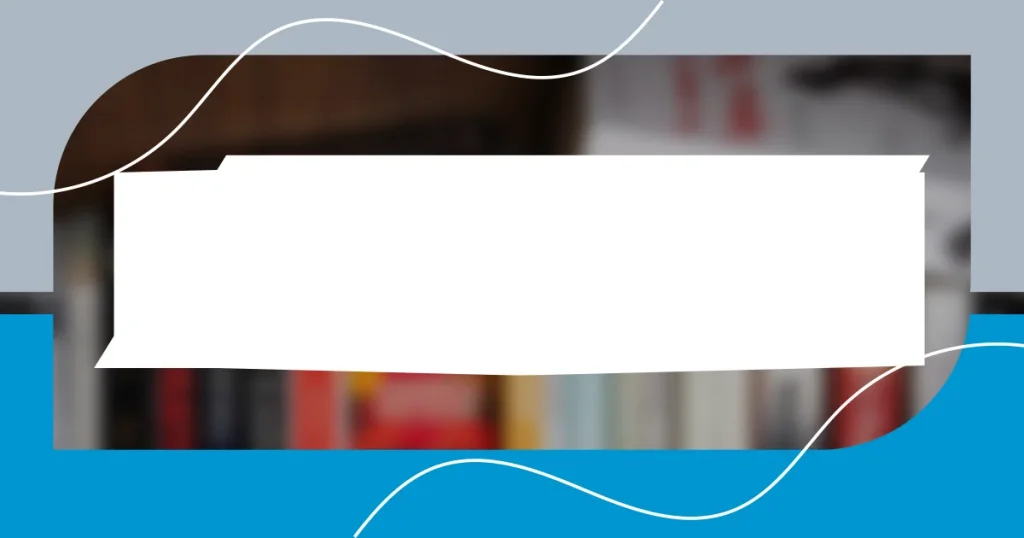Key takeaways:
- Genre mashups enhance reader engagement by creating unique emotional experiences and richer character development.
- Techniques for blending genres include identifying common themes, experimenting with structure, and utilizing layered conflicts.
- Challenges in genre mashups involve balancing conflicting elements, ensuring character authenticity, and navigating reader expectations.

Understanding genre mashups
Understanding genre mashups is like mixing your favorite ingredients in a recipe; when done right, it creates something uniquely delicious. I remember the first time I stumbled upon a book that blended science fiction with fantasy elements. It was such a refreshing experience, as I found myself immersed in worlds that simultaneously felt familiar and wildly original. Isn’t it fascinating how a single story can evoke multiple emotions and challenge our expectations?
When I explore genre mashups, I often reflect on how they can mirror the complexity of real life. Just like in our own experiences, where romance can intertwine with adventure or horror can touch on profound themes of grief, blended genres showcase the rich tapestry of human emotions and narratives. Have you ever noticed how a suspenseful thriller can suddenly reveal a deeply woven romantic subplot? That unexpected twist is what keeps readers on their toes!
I find that genre mashups invite us to break down walls and redefine boundaries. They inspire creativity and innovation, urging writers to experiment without fear of conventional limits. Why stick to one genre when you can create something novel and exhilarating? Every time I sit down to write, I’m excited to explore the possibilities of what might emerge when contrasting genres collide—the results can be surprisingly beautiful.

Benefits of genre mashups
The beauty of genre mashups is that they create a unique reading experience that can resonate with different audiences. I remember penning a short story that combined elements of horror with romance. The mix produced an eerie yet touching atmosphere where fear intertwined with love. Readers expressed how much they enjoyed navigating this emotional rollercoaster, showing me that boundaries can enhance engagement instead of limit it.
Another compelling benefit arises in the form of richer character development. When genres collide, characters often face diverse challenges that lead to profound transformations. For instance, in one of my projects, I crafted a character that started in a lighthearted romance but found unexpected horror elements complicating her relationships. This created layers in her personality and motivated her growth in unexpected ways. It’s fascinating to observe how these multifaceted journeys can forge deeper connections between characters and readers.
Finally, genre mashups boost creativity—not just for the writer, but for the reader as well. When I blend genres, I feel a wave of inspiration seeping into my writing process. It encourages me to think outside the box and challenge my creative limits. By surprising readers with unconventional narrative paths, I’m often reminded of the joy in exploration. This experimentation not only invigorates my writing, but it also fuels readers’ imaginations, inviting them to see stories through a new lens.
| Benefit | Description |
|---|---|
| Engagement | Mashups attract diverse audiences and evoke varied emotions. |
| Character Development | Combining genres leads to more complex character journeys. |
| Creativity | Inspires writers and readers to think outside conventional boundaries. |

Techniques for blending genres
Exploring techniques for blending genres often feels like navigating a vibrant art palette. One effective approach is to identify the core themes of each genre and find intersections. For example, I once combined the suspenseful structure of a thriller with the emotional exploration of literary fiction. This allowed me to create a gripping narrative where the stakes were not just external but deeply emotional, enhancing the overall impact on readers.
Here are some techniques I’ve found helpful for genre blending:
- Identify Common Themes: Focus on the underlying themes that connect both genres. This creates a cohesive narrative.
- Play with Structure: Experiment with the format of your story—maybe using a non-linear timeline often found in literary fiction within a fast-paced action narrative.
- Character Dynamics: Develop characters that embody traits from both genres, enriching their journeys. A detective with a flair for poetry can bring unique depth to a mystery.
- Layered Conflicts: Utilize conflicts from both genres; a romantic subplot can weave through a dystopian struggle, enhancing tension and emotional stakes.
- Atmosphere and Tone: The mood can be crucial too. Mixing the dark, eerie tones of horror with the light-hearted banter of a comedy can yield unexpected results.
I recall a project where I set a noir detective story in a fantastical world, filled with mythical creatures. The stark contrasts not only made the narrative intriguing, but they also allowed me to explore themes of morality and choice in a way that surprised my audience. Readers often commented on how the blending of aesthetics and thematic questions made them reconsider what a detective story could be, providing an enriching experience that exceeded their expectations.

Popular genre mashup examples
When I think about popular genre mashups, one that immediately comes to mind is “urban fantasy.” This genre blends the supernatural with modern-day settings, creating a world where magic intersects with everyday life. I remember getting lost in a series where vampires coexisted with humans in a bustling city. The struggle of characters trying to maintain their secret lives while navigating contemporary problems was both thrilling and relatable. It posed a wonderful question: how do we balance our true selves with societal expectations?
Another fascinating example is the blend of science fiction and romance, often seen in movies and novels alike. I found myself enchanted by a tale that explored love amidst dystopian backdrops. The characters grappled with not only their feelings but also the fate of the world. It’s intriguing to consider how love holds its ground even when the world around us is falling apart. Doesn’t that reflect our reality, where personal connections are our solace in chaos?
Then there’s the humorous spin on historical fiction. I once read a novel that depicted a famous historical event with a comedic twist. Watching serious historical figures navigate ridiculous scenarios had me in stitches. It made me wonder: how can we reinterpret the past to entertain and engage while still shedding light on its importance? These mashups redefine how we perceive different genres and make literature feel more alive and vibrant.

Writing exercises for genre mashups
Engaging in genre mashup writing exercises can be a delightful way to stretch your creative muscles. One exercise I often recommend is the “character swap.” Pick two characters from different genres and imagine a scene where they meet. For instance, envision a superhero finding common ground with a romantic hero. What would they discuss? How would their backgrounds clash or complement each other? This not only promotes creativity but also deepens your understanding of character dynamics.
Another effective exercise is to rewrite a classic scene from a different genre’s perspective. I’ve challenged myself to take a well-known horror moment and reimagine it in a cozy mystery setting. Picture the haunted house scene transformed into a quirky tea party filled with eccentric characters. It can be fascinating to see how altering the genre shifts the tone, theme, and reader engagement. What new insights arise from this change? You might be surprised at how fresh the story feels!
Lastly, I find that playing with dialogue styles can lead to exciting cross-genre results. Set up a conversation between characters that embody the essence of two genres—like a serious spy and a whimsical fairy. They may grapple with each other’s perspectives, revealing the absurdities in both. I remember crafting a scene like this, where the spy’s grim outlook clashed comically with the fairy’s carefree demeanor. It not only provided humor but sparked thoughtful questions about identity and perspective in storytelling. How might this blend lead to unexpected twists in your narrative?

Common challenges in genre mashups
When diving into genre mashups, one of the most common challenges I encounter is finding the right balance between conflicting elements. For example, I once tried to weave together horror and comedy in a short story about a ghost who just wanted to be taken seriously. Juggling the eerie atmosphere with humorous moments felt like walking a tightrope—if I leaned too far into one genre, the other would topple. Have you ever felt that creative push and pull?
Another hurdle is ensuring that character motivations resonate across genres. I remember crafting a character who was a detective in a fantasy realm. However, aligning their logical, methodical approach with a magical world filled with whimsical unpredictability proved tricky. It’s essential for characters to feel authentic, regardless of the genre shifts. How do you keep your characters grounded amidst such contrasting worlds?
Finally, readers might have preconceived notions of what to expect from a specific genre, and this expectation can stand in the way of seamless storytelling. I’ve experienced moments when beta readers expressed surprise at my genre-blending choices, feeling these decisions strayed too far from the norms. It made me reflect on how genre conventions are both a guideline and a barrier. How do you think we can challenge those expectations while still delivering an engaging narrative? Balancing these elements is pivotal to creating a cohesive and immersive experience for readers.

Tips for successful genre fusion
When fusing genres, it’s crucial to establish a strong thematic core that resonates across both styles. I’ve found that anchoring my narrative in universal themes, like love or loss, helps create a bridge between disparate genres. For instance, when I mixed romantic elements with a sci-fi backdrop, focusing on the human experience of longing made the unusual combination feel authentic. What themes are you drawn to that could seamlessly blend different genres?
Another valuable tip is to nurture your characters individually before merging their worlds. I remember working on a project where I built a detective with a meticulous eye for detail who melodramatically found herself in a whimsical fairy-tale realm. By enriching her backstory and motivations independently, I found that her reactions to the fantastical elements felt more believable and engaging. How do your characters’ personalities shape the story when they’re tossed into a new genre?
Lastly, don’t shy away from experimenting with tone. In my experience, the tone can be a guiding thread that ties the mashup together beautifully. I once wrote a lighthearted adventure story that unexpectedly shifted into a darker narrative, reflecting the protagonists’ growing stakes. This fluctuation enhanced tension and captivated readers. Have you thought about how tone can influence the journey and emotional depth of your characters?
















